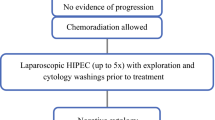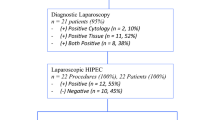Abstract
Purpose
Although laparoscopic hyperthermic intraperitoneal chemotherapy (LS-HIPEC) has been proven safe in patients with gastric adenocarcinoma and carcinomatosis or positive cytology, patient selection criteria remain unclear. Thus, we perform a retrospective analysis to identify factors associated with improved survival and resection rates.
Patients and Methods
Data for all patients undergoing LS-HIPEC for stage IV gastric adenocarcinoma between June 2014 and November 2018 were collected prospectively and analyzed for associations with survival and resection using uni- and multivariate logistic regression, Cox proportional hazards models, and Kaplan–Meier survival functions.
Results
Of 70 patients who underwent LS-HIPEC, 43 (61%) received two drugs (mitomycin C and cisplatin), and 27 (39%) received three drugs (mitomycin C, cisplatin, and paclitaxel). The two groups’ demographic and oncologic differences were not significant, although the three-drug group had a significantly lower rate of radiation therapy use (58% vs. 15%; p < 0.01). Univariate analysis revealed that poor differentiation [Cox hazard ratio (HR) 2.75; 95% confidence interval (CI) 1.34–5.63; p < 0.01], gross carcinomatosis (HR 3.10; 95% CI 1.52–6.30; p = 0.03), and ascites (HR 3.43; 95% CI 1.88–6.26; p < 0.01) were associated with shorter median survival. Gastrectomy was associated with improved overall survival (HR 0.32; 95% CI 0.15–0.70; p < 0.01). The resection rate of the 45 patients without ascites (38%) was significantly higher than that of the 25 patients with ascites (0%; p < 0.01).
Conclusions
Our findings identify ascites as a significant prognostic factor for gastric cancer patients with peritoneal metastases undergoing LS-HIPEC. Our findings can be used to help identify patients who are unlikely to proceed to resection after LS-HIPEC and are good candidates for novel therapeutic approaches or clinical trials.




Similar content being viewed by others
References
Badgwell B, Cormier JN, Krishnan S, et al. Does neoadjuvant treatment for gastric cancer patients with positive peritoneal cytology at staging laparoscopy improve survival? Ann Surg Oncol. 2008;15(10):2684–91.
Ajani JA, D’Amico TA, Almhanna K, et al. Gastric cancer, version 3.2016, NCCN clinical practice guidelines in oncology. J Natl Compr Cancer Netw. 2016;14(10):1286–312.
Thomassen I, van Gestel YR, van Ramshorst B, et al. Peritoneal carcinomatosis of gastric origin: a population-based study on incidence, survival and risk factors. Int J Cancer. 2014;134(3):622–8.
Neuwirth MG, Alexander HR, Karakousis GC. Then and now: cytoreductive surgery with hyperthermic intraperitoneal chemotherapy (HIPEC), a historical perspective. J Gastrointest Oncol. 2016;7(1):18–28.
Yonemura Y, Canbay E, Endou Y, et al. Peritoneal cancer treatment. Expert Opin Pharmacother. 2014;15(5):623–36.
Sugarbaker PH, Stuart OA, Vidal-Jove J, Pessagno AM, DeBruijn EA. Pharmacokinetics of the peritoneal-plasma barrier after systemic mitomycin C administration. Cancer Treat Res. 1996;82:41–52.
Flessner MF. The transport barrier in intraperitoneal therapy. Am J Physiol Renal Physiol. 2005;288(3):F433–42.
Bonnot PE, Piessen G, Kepenekian V, et al. Cytoreductive surgery with or without hyperthermic intraperitoneal chemotherapy for gastric cancer with peritoneal metastases (CYTO-CHIP study): a propensity score analysis. J Clin Oncol. 2019;37(23):2028–40.
Badgwell B, Blum M, Das P, et al. Lessons learned from a phase II clinical trial of laparoscopic HIPEC for gastric cancer. Surg Endosc. 2018;32(1):512.
Newhook TE, Agnes A, Blum M, et al. Laparoscopic hyperthermic intraperitoneal chemotherapy is safe for patients with peritoneal metastases from gastric cancer and may lead to gastrectomy. Ann Surg Oncol. 2019;26(5):1394–400.
Desiderio J, Chao J, Melstrom L, et al. The 30-year experience—a meta-analysis of randomised and high-quality non-randomised studies of hyperthermic intraperitoneal chemotherapy in the treatment of gastric cancer. Eur J Cancer. 2017;79:1–14.
Badgwell B, Blum M, Das P, et al. Phase II trial of laparoscopic hyperthermic intraperitoneal chemoperfusion for peritoneal carcinomatosis or positive peritoneal cytology in patients with gastric adenocarcinoma. Ann Surg Oncol. 2017;24(11):3338–44.
Blum Murphy M, Ikoma N, Wang X, et al. Phase I trial of hyperthermic intraperitoneal chemoperfusion (HIPEC) with cisplatin, mitomycin, and paclitaxel in patients with gastric adenocarcinoma and associated carcinomatosis or positive cytology. Ann Surg Oncol. 2020;27:2806–11.
Dormann CF, Elith J, Bacher S, et al. Collinearity: a review of methods to deal with it and a simulation study evaluating their performance. Ecography. 2013;36(1):27–46.
Hastie T, Tibshirani R, Friedman JH. The elements of statistical learning: data mining, inference, and prediction. Berlin: Springer; 2009.
Benizri EI, Bereder JM, Rahili A, Bernard JL, Benchimol D. Ascites and malnutrition are predictive factors for incomplete cytoreductive surgery for peritoneal carcinomatosis from gastric cancer. Am J Surg. 2013;205(6):668–73.
Ishigami H, Fujiwara Y, Fukushima R, et al. Phase III trial comparing intraperitoneal and intravenous paclitaxel plus S-1 versus cisplatin plus S-1 in patients with gastric cancer with peritoneal metastasis: PHOENIX-GC trial. J Clin Oncol. 2018;36(19):1922–9.
Randle RW, Swett KR, Swords DS, et al. Efficacy of cytoreductive surgery with hyperthermic intraperitoneal chemotherapy in the management of malignant ascites. Ann Surg Oncol. 2014;21(5):1474–9.
Acknowledgement
The authors thank Joseph Munch of the Department of Scientific Publications for editorial assistance. This trial was supported by the Holly Clegg Gastric Cancer Research Fund and the No Stomach for Cancer Award for Gastric Cancer Research.
Author information
Authors and Affiliations
Corresponding author
Ethics declarations
Disclosure
The authors have no competing interests to report.
Additional information
Publisher's Note
Springer Nature remains neutral with regard to jurisdictional claims in published maps and institutional affiliations.
Rights and permissions
About this article
Cite this article
White, M.G., Kothari, A., Ikoma, N. et al. Factors Associated with Resection and Survival After Laparoscopic HIPEC for Peritoneal Gastric Cancer Metastasis. Ann Surg Oncol 27, 4963–4969 (2020). https://doi.org/10.1245/s10434-020-08842-7
Received:
Accepted:
Published:
Issue Date:
DOI: https://doi.org/10.1245/s10434-020-08842-7




